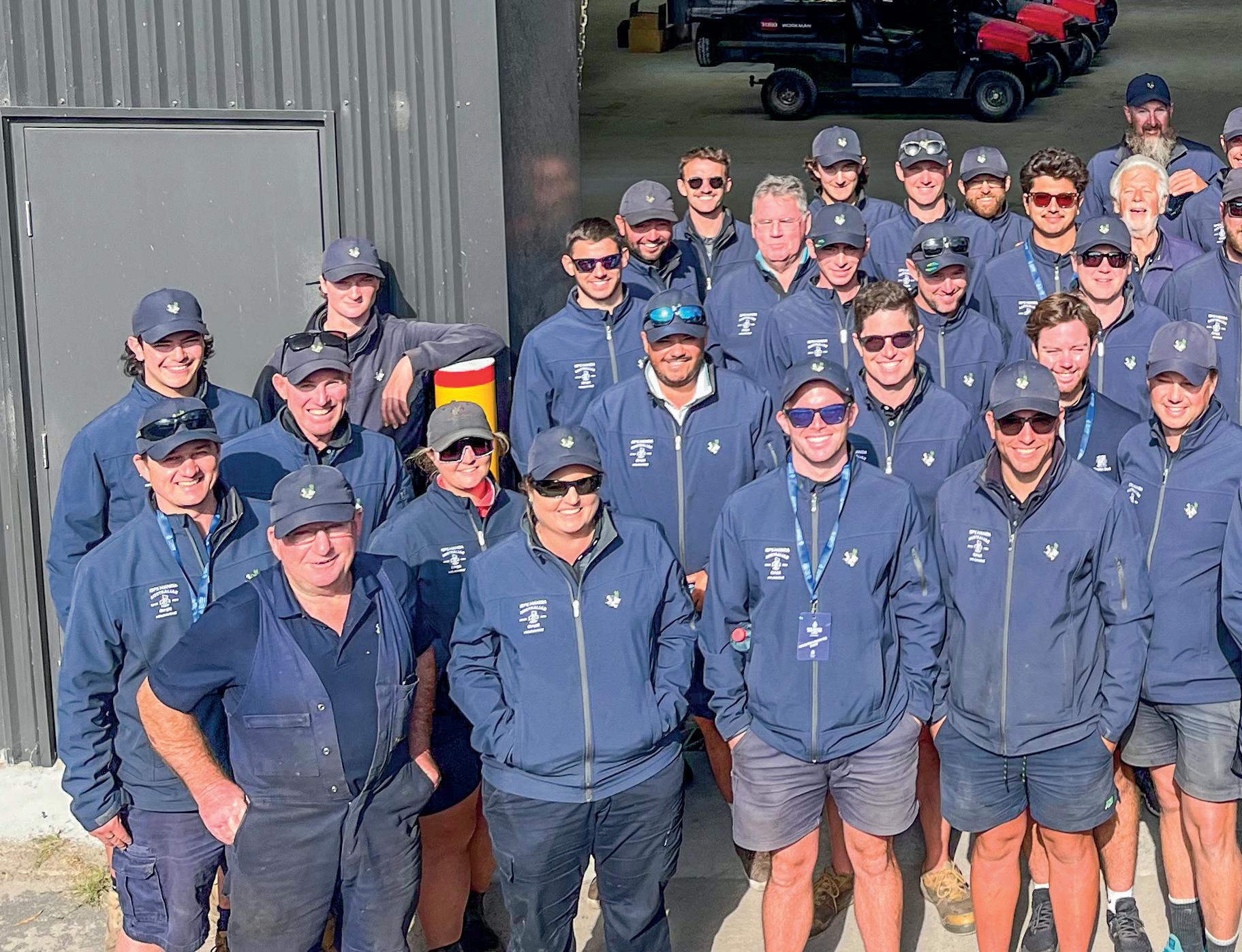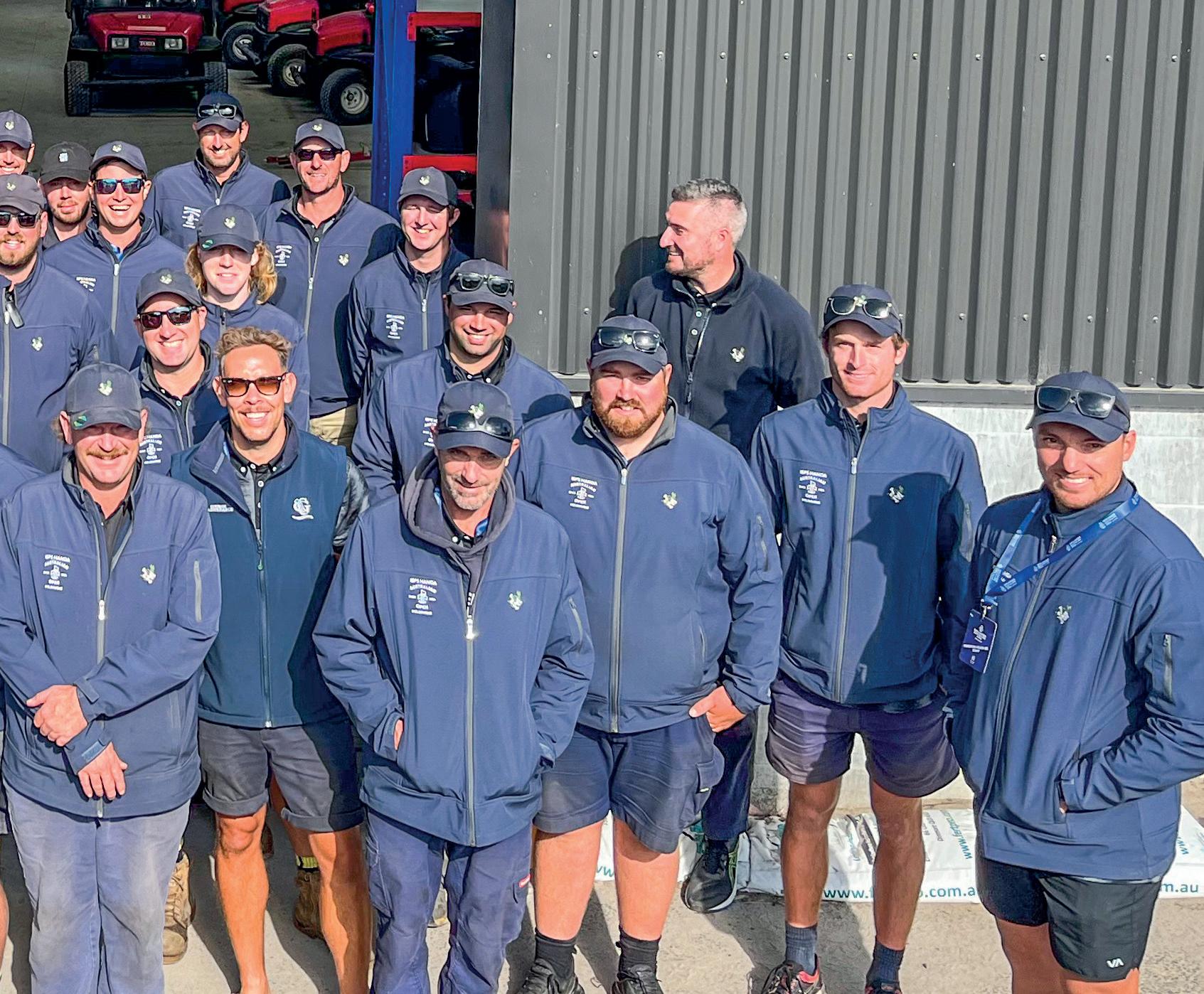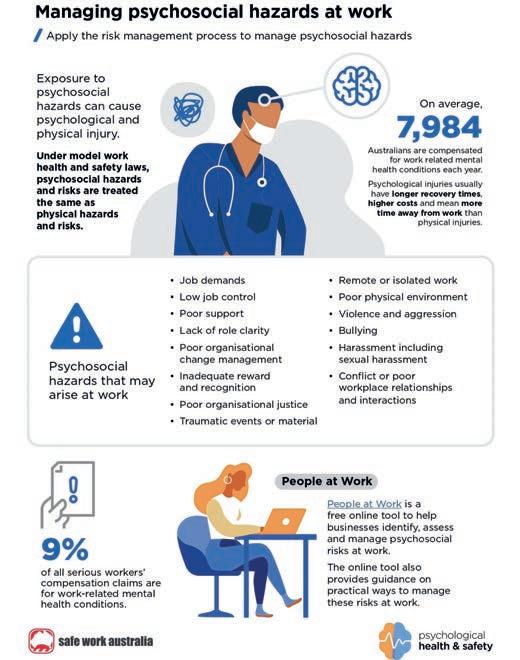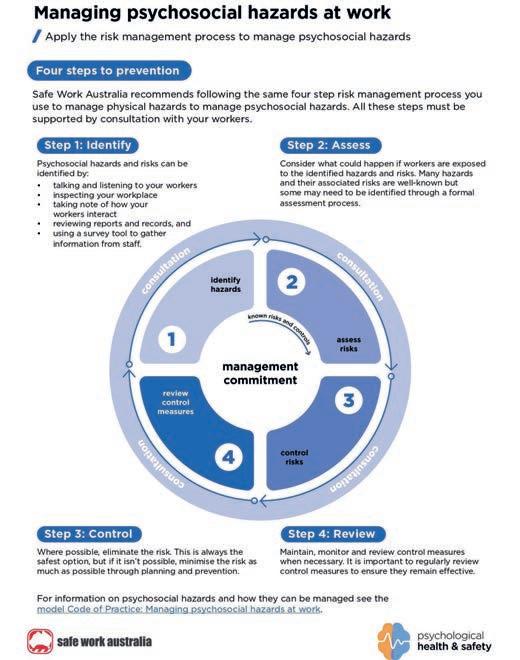
4 minute read
What makes a great workplace culture?
Psychosocial Hazards And Managing Stress At Work
The recent passage of the Work Health and Safety (Psychosocial Hazards and Risks)
Advertisement
Amendment Regulation 2022 (in nearly all states and territories across Australia) means that employers now have a more explicit duty to eliminate or minimise workplace psychosocial risks. Whilst Victoria is not yet under the WHS Act, there are still explicit requirements from WorkSafe Victoria to manage psychosocial hazards and risks.
Summary
• From 1 October 2022, the Regulation detailing employer responsibility to respond to, manage and prevent psychosocial risks has come into effect
• The implementation of the Regulation on psychosocial risks is a warning for employers nationally, to undergo a risk assessment and review their control measures in relation to psychosocial hazards
Background
While the concept of psychological health isn’t new, it hasn’t been clearly and concisely addressed in workplace legislation until now. This is despite the fact that, over the past decade, there has been an increase in psychological health issues, and a decrease in the rate of physical injuries, in the workplace.
Psychological injury - the Regulation
Psychological health is currently addressed in the Work Health and Safety Act 2011(the WHS Act) by way of inclusion in the definition of ‘health’ in Section 4. This means that employers are already under an obligation to ensure, so far as reasonably practicable, the psychological health of their workers while they are at work.
However, the model WHS regulations and the model Codes of Practice provided no further assistance to employers, and other duty holders, on how to meet their obligations regarding psychological health, and so this wasn’t further dealt with by the WHS Regulations.
Psychosocial hazards
Psychosocial hazards are factors in the design or management of work that increase the risk of work-related stress and can lead to psychological or physical harm. Examples of psychosocial hazards might include poor supervisor support or high job demands.
Employees are likely to be exposed to a combination of psychosocial hazards. Some hazards might always be present at work, while others only occasionally. There is a greater risk of work-related stress when psychosocial hazards combine and act together, so employers should not consider hazards in isolation.
Psychosocial hazards do not necessarily reveal the causes of work-related stress. Causes are likely to be specific to the employee, work or workplace. Senior management should identify which psychosocial hazards negatively affect employees’ health and well-being and take appropriate action to control the impact of those hazards.
A psychosocial hazard is anything that could cause psychological harm (e.g. harm someone’s mental health). Common psychosocial hazards at work include:
• Job demands
• Low job control
• Poor support
• Lack of role clarity
• poor organisational change management
• inadequate reward and recognition
• poor organisational justice
• traumatic events or material
• remote or isolated work
• poor physical environment
• violence and aggression
• bullying
• harassment, including sexual harassment, and
• conflict or poor workplace relationships and interactions
Kingston Heath Golf Club - Focus on ownership, safety & culture
Hayden Mead, Golf Course Superintendent at Kingston Heath Golf Club places a safety culture and team wellbeing at the heart of team operations - “A great, safe work environment is very important for numerous reasons; foremost the safety of staff, boosting staff morale and productivity, creating a cohesive team that everyone feels a part of and everyone takes ownership of the safety and policies and procedures of the club. The teams wellbeing and support of each other is at the heart of our culture”

How Psychosocial Hazards Cause Harm
Psychosocial hazards can create stress. This can cause psychological or physical harm. Stress itself is not an injury. But if workers are stressed often, over a long time, or the level of stress is high, it can cause harm.
Psychological harm may include anxiety, depression, post-traumatic stress disorder, or sleep disorders. Physical harm may include musculoskeletal injuries, chronic disease or fatigue related injuries.
Psychosocial hazards may interact and combine
Psychosocial hazards may interact or combine to create new, changed or higher risks. It is important to consider all the psychosocial hazards workers may be exposed to when managing psychosocial risks.

Some hazards may not create psychosocial risks on their own but may do so if combined with other hazards. For example, when workloads are high the risk may increase if workers cannot take breaks or there is no one around to help. Some hazards may only create risks on their own when severe.
Managing psychosocial risks
A person conducting a business or undertaking (PCBU) must eliminate psychosocial risks, or if that is not reasonably practicable, minimise them so far as is reasonably practicable.
For information about managing and reducing psychosocial risk see the Code of Practice: Managing psychosocial hazards at work.
What does this mean for employers and officers?
The implementation of the Regulation regarding psychosocial risks is a warning bell for employers nationally, to undergo a risk assessment and review their control measures in relation to psychosocial hazards.
It recommends managing psychosocial hazards by following the same four-step risk management process that is used to manage physical hazards. This involves undertaking the following steps in consultation with workers:

• Identify any psychosocial risks;
• Assess the impact of all identified risks;
• Control risks by eliminating and minimising them as much as possible; and
• Review any control measures implemented, to ensure they are effective
Managing Psychosocial Hazards at Work: Mona Vale Golf Club Course Maintenance Team
Nick Tapley and his crew at Mona Vale Golf Club Course Maintenance have made a commitment to each other to remove or minimise psychosocial risks at work wherever possible.
With communication a pillar of their strategy as a team, individuals are free to ask questions and talk to others about their experience without concern of judgment.
“It’s so important to give the crew input into the work they are doing and some diversity in their jobs. We have a great setup where the team get the opportunity to try a range of different tasks to keep things interesting” -
Makes
CULTURE?
Nick Tapley, Course Superintendent,
Mona Vale Golf
Club











